Tana Toraja in Indonesia (South Sulawesi) is often called the land of death. Spectacular funerals in Toraja, boat-shaped houses and old tradition which prolongs life after death are facts that make this place one of the most incredible I have ever visited. Are you curious to know how the funeral in Toraja looks like? I invite for a journey through old rituals as well as a bunch of practicals on how to go for the funeral in Toraja, what to bring and how to dress. It’s surely not a place for everyone. Be aware that this article includes sensitive content!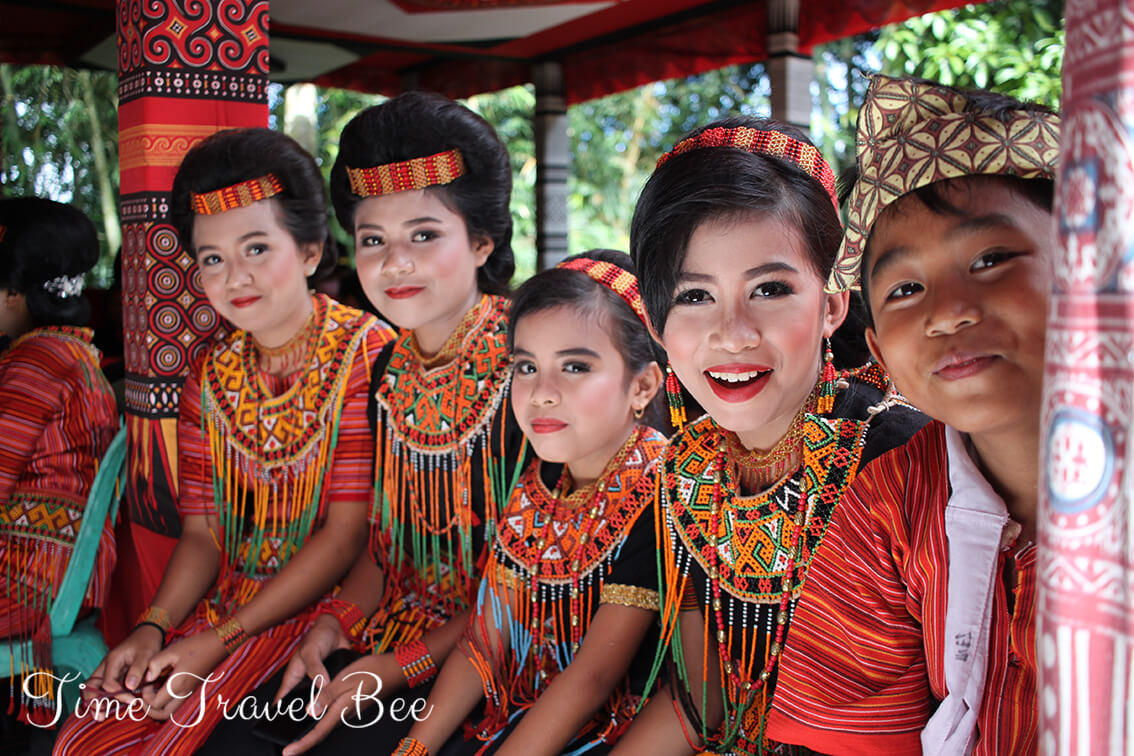
The land of death
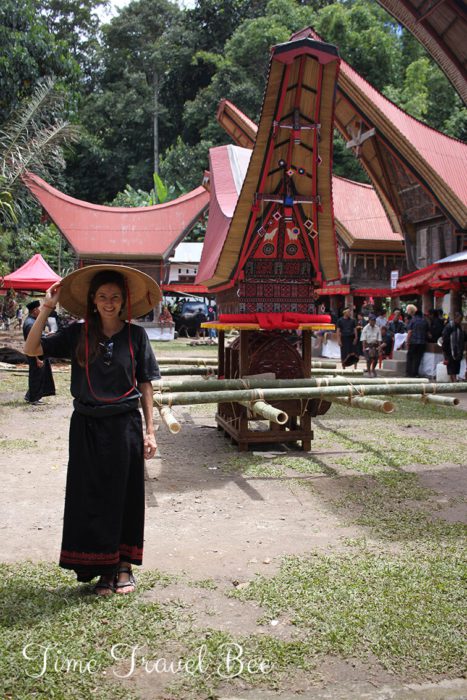 Tana Toraja region has a lot to offer from unique culture to beautiful mountain views, waterfalls or caves. From all these undoubtedly, the most controversial yet fascinating are the funerals in Toraja (tomate) that are the largest in the world.
Tana Toraja region has a lot to offer from unique culture to beautiful mountain views, waterfalls or caves. From all these undoubtedly, the most controversial yet fascinating are the funerals in Toraja (tomate) that are the largest in the world.
Traveling in Tana Toraja I could clearly see how important in the beliefs is life after death. I have never seen so many skulls, bones, graves and celebration so festive like there. When a family member dies, they keep the body in the house for a few weeks or even years to pay respect and collect money for the funeral. Family would visit the deceased, give food 3 times per day, talk to the person, clean the body and change clothes.
The word tana means land and toraja is a connection of the words “to” – people and “raja” means mountain or someone with high status, like a king. So Tana Toraja is literally land of the people from highlands or according to another etymology, land of the royal people.
The biggest funerals in the world
The funeral in Toraja lasts for a couple of days, depending of the social status and money the family can spend. Usually, it’s around one week including preparations, welcoming guests, sacrifice and lastly, burying the body. I had a chance to go for one funeral in Toraja which took a few days, and I got to see Torajan traditions, dances and ritual sacrifice of animals.
Before the ceremony I went for the preparation day. The place was ready to host hundreds of guests. There were temporary bamboo constructions with a roof and floor, where people could sit and eat during the ceremony. Women from the community helped each other to prepare the food and decorate the place with red ornaments, that are symbolic for Torajan funeral. During the preparation, I helped ladies to pill the veggies and got drunk with a palm wine, which they love to drink in Toraja. It looked weird to me that the wine barrel stands just in front of the coffin, but that was just a prelude of how weird it can get…
How the Torajan funeral ceremony looked like?
Finally, the day of welcoming guests arrived and gathered hundreds of incomers. I was really excited to come for this unique event. The closest family as well as people from the high class had privilege to sit in the rice barns. I saw a few buffalos standing all around, waiting for their turn to die, together with dozens of black pigs. Those were making a lot of noise because they were tied to a bamboo stick and thrown whenever on the square. However, it seemed like this fact disturbs only me.
When all the guests arrived a speech of the ceremony’s master started the event. In the middle of the square, there was a boat-shaped house platform with the coffin.
The master of the ceremony invited people to dance around the coffin. I noticed that elders from the family took their hands, holding just by the little finger and performed a slow dance. One lady invited me to join them, so I did. I had no idea what are the steps so I was really clumsy, but after a minute I got it. Coming to the funeral in Toraja, I felt like participating in a festival. It’s fascinating that the funeral is a cheerful event, unlikely in my homeland and the neighbour countries. I found only one place in Europe with a tiny exception. Romania has one happy cemetery, the only place like that in the world.

Traditional dance
After the dances, the priest came to make a speech. Nowadays, the majority of Torajans are Christians, and they mix the old tradition with modern religion. When the priest finished another round of dances started. This time by a group of man hired for this purpose. They sang old mantras with low voices and danced, all in tact surrounding the coffin. It looked very impressive.
The procession
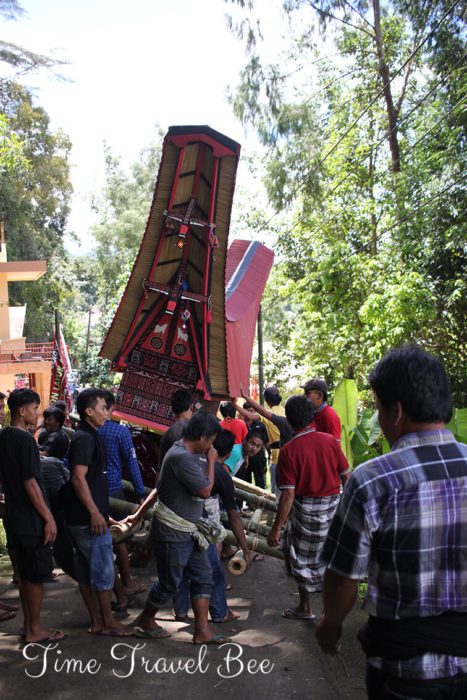 This part was definitely a surprise for me. Around 20 men took the wooden platform with a coffin and all the guests followed for the procession around the village. As I mentioned a funeral in Toraja is not really a sad event, as it’s meant to cheer up the soul. What surprised me was that the men were jumping with the coffin, dancing, shifting it from one side to another and having a lot of fun. The ceremony’s master was saying a bunch of stupid and even dirty jokes to encourage them. The faster they were carrying it and the more cheerfully, the better. It was wild! The men shouting, jumping, the coffin almost falling from the construction. Crazy! You know that feeling that something is funny but you are not really sure that it’s a good manner to laugh? Substantially, there was a dead body inside, so I wasn’t sure, if that is all right.
This part was definitely a surprise for me. Around 20 men took the wooden platform with a coffin and all the guests followed for the procession around the village. As I mentioned a funeral in Toraja is not really a sad event, as it’s meant to cheer up the soul. What surprised me was that the men were jumping with the coffin, dancing, shifting it from one side to another and having a lot of fun. The ceremony’s master was saying a bunch of stupid and even dirty jokes to encourage them. The faster they were carrying it and the more cheerfully, the better. It was wild! The men shouting, jumping, the coffin almost falling from the construction. Crazy! You know that feeling that something is funny but you are not really sure that it’s a good manner to laugh? Substantially, there was a dead body inside, so I wasn’t sure, if that is all right.
On the top of that, the ceremony’s master seeing me – a white “bule” tourist taking photos, he asked me to sit on the construction with the coffin so it will be more funny. Seriously?! And what should I do now? One part of me saying that I should respect different custom and another part yelling “what the heck don’t sit near the coffin, it’s wrong”! Lastly, I sat and they carried me together with the dead body.
Sitting there felt extremely weird especially when we entered back the ceremony singing and jumping and everyone was looking at me. All the people were laughing but I saw one tourist with a face saying: “What the fuck is she doing there? It’s so disrespectful!” At the end they started to jump with the construction really high and I fell down. OMG! What a scene!
It’s interesting how the same things would look very disrespectful to the deceased in my country. On the funereal ceremony in Toraja, they have a lof of fun. They dance, wear beautiful clothes, drink and celebrate. Why is all that? According to Tarajans, it’s the biggest party in humans life. Yes, you got it right – life.
Torajans believe that the person after death is just sleeping or being sick so they treat it as alife. They would put food and drinks next to the body, talk to the person and take care of him/her. If you go and visit the deceased in the house to pay respect, you must ask him/her for the permission to leave, as you would of a living host. The actual funeral and end of the life on Earth is when they burry the body.
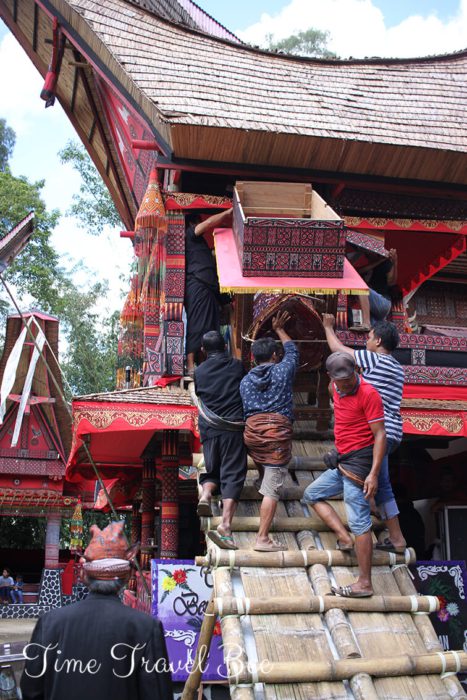 What’s more, for the funeral in Toraja there is always a special tower, where after the procession the coffin is placed. They believe the deceased is watching the party from there, as from the tower can see all the people celebrating, dancing and drinking wine. Before Christianity, there was a real dead body sitting and watching, now it lays in the coffin.
What’s more, for the funeral in Toraja there is always a special tower, where after the procession the coffin is placed. They believe the deceased is watching the party from there, as from the tower can see all the people celebrating, dancing and drinking wine. Before Christianity, there was a real dead body sitting and watching, now it lays in the coffin.
And now all this beautiful ceremony is going to turn into a massacre…
Ritual animals sacrifice
Here comes the bloody part, so better skip it if you are sensitive! After they put the coffin up to the tower, a man came with a huge buffalo. Torajan people believe the sacrifice must be made, as the buffalo takes the soul to heaven. First, they placed a stick to tie the animal in the middle of the square, so the buffalo cannot run away. Secondly, one man took the head of the animal high up and cut his throat with one sharp stroke. The buffalo started to weaken and choke blood coming out to finally fall dead. Liters of blood started to cover the square.
The silence was gone and replaced with a dance and bustle. A few men started cutting the buffalo in pieces at the place. Just a minute after there was a massacre of the pigs happening in front of everyone. The dogs around were getting crazy. Pigs one by one were killed with a knife, and blood filled all the square. The feast has started!
Along the feast on the third day of the ceremony, there was bullfighting nearby. Gambling is often organised on the funeral not only to entertain guests that came for a few days, but also to support budget of the family organising the whole event. Interestingly, it was the same case on Borneo, when I visited Dayak’s tribe funeral.
During the other days of the ceremony, a lot of animals were sacrificed. Every day I could see more and more blood on this square, that used to be so green and beautiful before. The scenes of killing and chopping the buffalos and pigs in front of everyone will surely stay in my memory. It was the first time for me to see a massacre like that. I don’t find the words to describe how shocking and sad it was.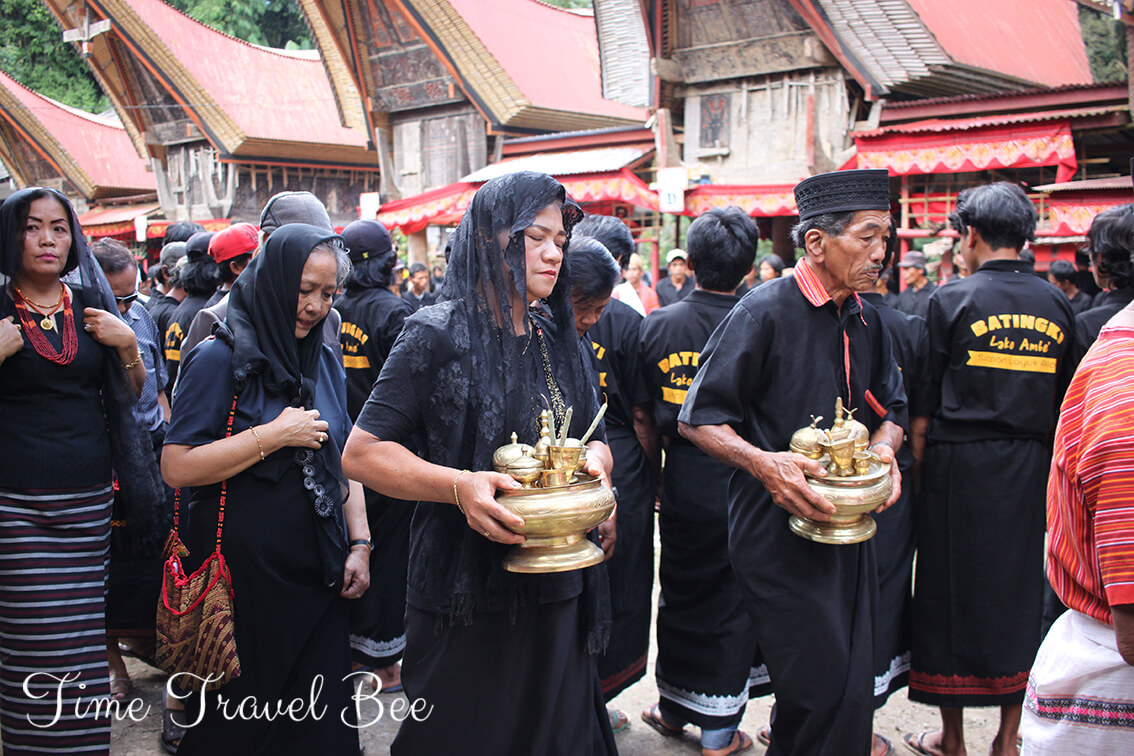
Why buffalos of Toraja are so special?
 Torajan people believe that buffalo will take the soul to Punia (heaven) and pig will guide them. On every funeral at least one buffalo and one pig must be sacrificed. However, with time people started to kill more and more, showing their social status as buffalo symbolises prosperity.
Torajan people believe that buffalo will take the soul to Punia (heaven) and pig will guide them. On every funeral at least one buffalo and one pig must be sacrificed. However, with time people started to kill more and more, showing their social status as buffalo symbolises prosperity.
Funeral ceremony of the low class means 1 or 2 buffalos will die; high class minimum 20 buffalos, but it can be even 50! In Tana Toraja there are around 24 types of water buffalos, and people are crazy about them. The buffalos have different length and shape of the horns, different colours and of course, price. Some of them are albinos, with blue eyes. Those are the most expensive and so precious. An albino buffalo can cost from $8000 to even $50 000. Not all the buffalos are sacrificed during the ceremony. The family donates some of them to the church or orphanage.
The water buffalos are so precious and important only in this place of the world. In Rantepau there is even unique buffalo market. It can take a very long time to choose the right buffalos for the funeral. It’s also a huge business in Tana Toraja. Owning a buffalo brings a lot of responsibility to protect it and a lot of benefit for selling. There are many people that can make a living by taking care of somebody’s buffalo.
Burying the body in Toraja
On the final day of the ceremony they carried the coffin again, singing and jumping cheerfully to finally place it in the grave. Traditionally, the body is buried in the stones or caves but nowadays as most of the people are Christian, they often use Christian cemetery. All the horns from the sacrificed buffalos will end up nailed to the house of this community.
In the region I saw a few burial caves and huge stones with man-made holes in it. Interestingly, I also saw the hanging coffins, exactly the same as those hanging on the cliffs in Sagada, Philippines! Families from high class additionally made the wooden replica of the dead (tau tau), which would sit in front of the grave. Some of the graves were destroyed and covered with the others, newer coffins. It all looked like a mess with the bones and skulls around.
Additionally, people bring food, water and cigarets for the dead, just like we bring candles when we go to the cemetery. The graves all around Toraja are surrounded by a bunch of cigarets and plastic water bottles. If the family of the dead is still alife, sometimes they open the coffin to clean the bones and change the clothes of the dead. In this way family show that they still remember and love the person.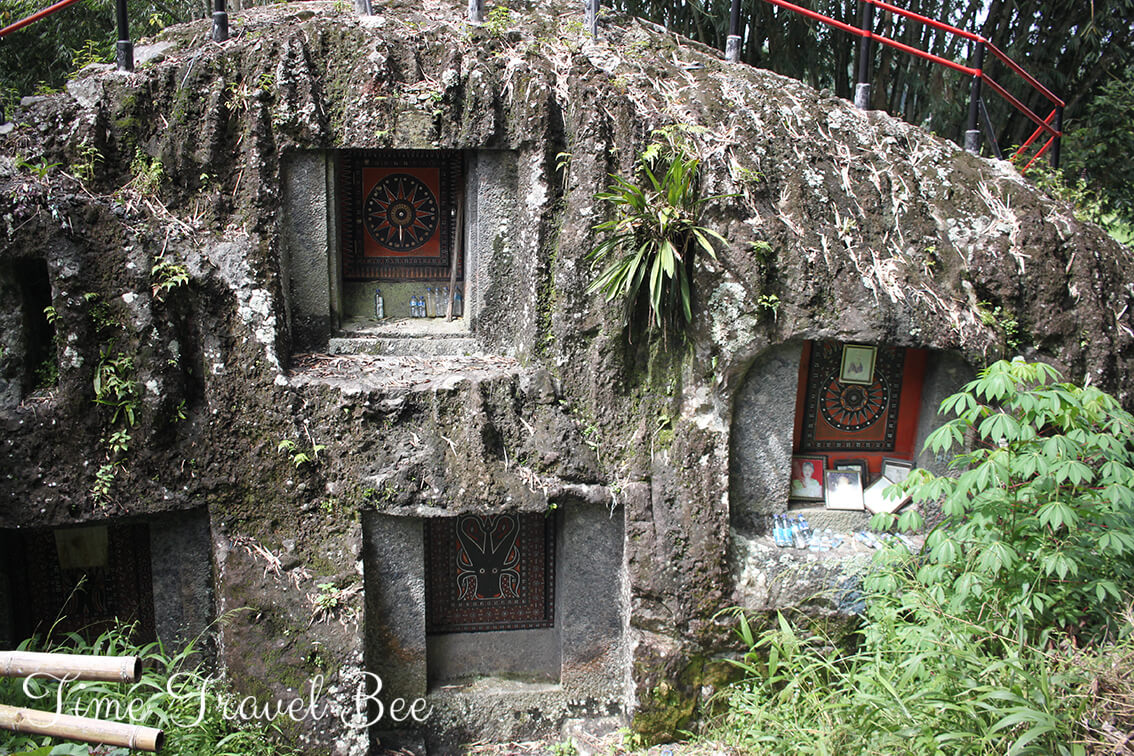

Baby grave
Very particular were baby graves in Toraja. Newborn babies which died before their tooth grew, were not buried in the grave as the others. Torajan people believe that they should rest on the certain type of a tree, which resin is white like a milk. The baby would then get milk from the tree after death, as they cannot get it from the mother anymore. I have seen a few trees with a brown bundle attached.
In some places in Toraja region, you can spot megalithic stones which basically look like a long stone placed in the ground vertically. Those are memorial stones of the big funerals of high-class people. They usually stand near the traditional villages, where the funerals took place. I will talk more about it in the post on what to see in Toraja. (coming next)
Dresscode on the funeral in Toraja
During the funeral ceremony in Toraja people wear black clothes as a sign of mooring. Normally, they wear t-shirt and sarong, both black, usually with traditional pattern in different color. Ladies additionally have typical torajan bags and sometimes a bamboo hat. Children from the family of the deceased wear traditional clothes of Toraja for ceremonies, which are rich in colors and decorations. They welcome the guests and show them where to sit. If you don’t travel with black things, try to borrow, otherwise wear the darkest clothes you have. I saw tourists coming in whatsoever, and nobody will tell you a thing, but it’s just more respectful to wear black.
What to bring to the funeral in Toraja?
When I was going for the ceremonies of Dayak tribe in East Kalimantan, my guide from couch surfing always told me to bring coffee and sugar. Here, in Toraja was pretty much the same. I saw that some tourists don’t bring anything, most probably didn’t know what to bring to the funeral in Toraja. To show respect it’s nice, if you get some sugar with coffee or cigarets. When you arrive to the venue try to find some members of the family and give it to them. They will surely welcome you with a smile.
When is the best time to come to Tana Toraja?
The high season is Toraja is from June until September. This is when most of the funerals happen as well as Toraja is packed with tourists. The other parts of the year there are rather few tourists and not so many funerals. However, as the traditional funeral ceremony in Toraja lasts for a few days, you will more likely have a chance to see one anytime of the year if you stay there for a couple of days. I came in the end of April and had a chance to see a big ceremony as well as a preparation for another one while going around on the bike.
How to see the funeral in Toraja?
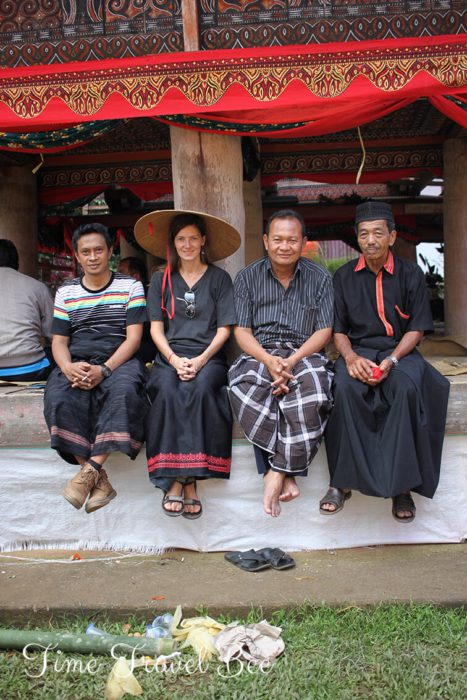 There are two options on how to see the funeral in Toraja. The first one is the easiest and the most popular – to hire a guide to take you for the ceremony. The guides are easy to find, however, it’s difficult to find a good one, which would speak fluent english and have a great knowledge. To find a guide in Toraja, you don’t have to search much. They usually “hunt” for tourists on their arrival. Otherwise, your guest house will surely have a “secret contact” with a guide who pays them for recommendations. The same situation with the various tourist agencies or tourists information services in Rantepao city. It’s a huge business and guides are relatively expensive, from 300 to 500 thousand rupiah per day.
There are two options on how to see the funeral in Toraja. The first one is the easiest and the most popular – to hire a guide to take you for the ceremony. The guides are easy to find, however, it’s difficult to find a good one, which would speak fluent english and have a great knowledge. To find a guide in Toraja, you don’t have to search much. They usually “hunt” for tourists on their arrival. Otherwise, your guest house will surely have a “secret contact” with a guide who pays them for recommendations. The same situation with the various tourist agencies or tourists information services in Rantepao city. It’s a huge business and guides are relatively expensive, from 300 to 500 thousand rupiah per day.
Summing up, I want you to be careful which guide you take and not blindly take the one hotel or tourism office recommends. Remember they have a deal. My advice is to try to meet the guide in person and talk with him for couple of minutes to check what is his offer, where will he take you, just for the fineral or also some interesting spots, and most of all if you can understand his English. The tradition of Toraja is fascinating, and you don’t want to miss the explanation. Keep in mind there are plenty of guides and the price is high. If 500 k plus possible tips doesn’t sound high to you, know that the average salary in this region is 2,5 million rupiah.
Second option is to rent a scooter and see the funeral by yourself. But how to find one? And this is the hardest step. If you rent a scooter and just go around the villages, you may be lucky to see one, as they are huge parties. Another option is to try asking in the tourism office, but they may want to hide the information about the location in order to sell you to the guide.
Third option is that you can rent a guide for one day to show you the funeral, and if you want to go for the other days of the funeral you can go by yourself as you already know where it is. The guides will do everything to earn money on you, even show you wrong direction for the funeral. They will also tell you that you can enter the funeral ceremony only with a guide, but it’s not true. From my experience everything could be done by yourself, but you need to have a couple of days in Toraja like a week or so and make contact with as many locals as possible. Lastly, don’t come to Toraja just for the funeral, this region has much more to offer.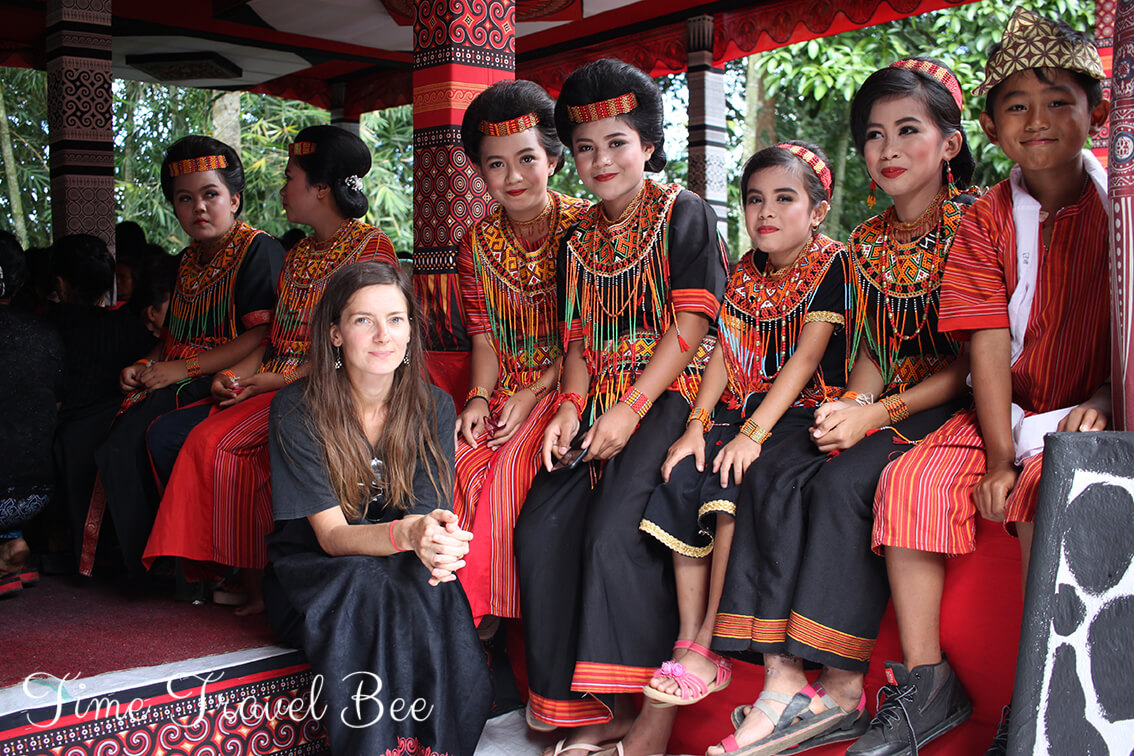
The Bee is a nature lover and tea addict. Loves the idea of slow life and responsible traveling, constantly trying to improve to bee more eco-friendly. Appreciates old cultures and traditions, loves to immerse with locals, listen to ethnic music as well as taste regional food and drinks. Her favorite spots while traveling are family houses and street markets.
